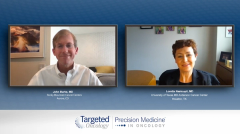
Combination Therapy in Patients With R/R DLBCL
Insight into the combination of tafasitamab plus lenalidomide for the treatment of relapsed/refractory diffuse large B-cell lymphoma.
Episodes in this series

John Burke, MD: If you see a patient, Loretta, who’s maybe a candidate for tafa-len [tafasitamab plus lenalidomide], but also maybe a candidate for CAR [chimeric antigen receptor] T-cell therapy, does it ever cross your mind that, “Maybe I should go with the relatively more well tolerated treatment, like [tafasitamab and lenalidomide], versus CAR T?” How do you make that distinction between your patients?
Loretta Nastoupil, MD: I think we all want patients to go into remission, and as oncologists, I always tell our trainees we’re eternal optimists, so we’re generally only thinking about this line of therapy, and if I can get a meaningful remission duration, I hope I don’t have to address that next relapse. I do think the overall survival we’ve seen thus far with [tafasitamab and lenalidomide] is quite striking. I also agree with your comment that it appears to be even better the earlier you use it in the disease course. I will potentially use it more frequently in the second line than in third line or later. I will use it in patients for whom I feel salvage chemotherapy is not a great option. Again, potentially older, frailer patients where ICE [ifosfamide, carboplatin, etoposide] or DHAP [dexamethasone, cytarabine, platinum]-based approaches are generally poorly tolerated, and I think it will likely perform better than a gemcitabine-based salvage.
To me, that’s sort of a no-brainer. I think the question that has been posed is, what about those patients who are a little beat up from frontline chemotherapy, didn’t necessarily tolerate CHOP [cyclophosphamide, doxorubicin, vincristine, prednisone] that well, but they got through all 6 cycles, and they’re really not interested in doing more intensive chemotherapy? But yet if they respond to that salvage chemotherapy, it would be appropriate for salvage pending the final results of the randomized studies that we can all delve into. I think I would give [tafasitamab and lenalidomide], and if they respond, potentially continue them on, and not worry too much about needing CAR T later. We haven’t seen enough data yet to know how well CD19 is preserved in the majority of patients who get [tafasitamab and lenalidomide]. We’ve seen some data showing that there are still patients who post-[tafasitamab and lenalidomide] have CD19 expression. But again, I’m going to defer the concerns about the third line until I actually need it.
John Burke, MD: When you talk to referring doctors and they say to you, “Hey, I have a patient, but it may take them a couple months to get their CAR T-cell therapy. Can I use [tafasitamab and lenalidomide] in the interim?” Do you have concerns about that, as you said eliminating CD19 from the cells and making your CAR T-cell therapy less effective? What’s your response to those referring doctors?
Loretta Nastoupil, MD: I do think that going into CAR T with stable lymphoma, meaning it’s not rapidly progressing, and recognizing it’s going to take me several weeks, I would love for them to give an effective therapy that gives me more time and less pressure to get CAR T approved. Something like [tafasitamab and lenalidomide] should not have a negative impact on T-cell fitness, as opposed to for instance giving bendamustine and polatuzumab prior to that collection. I wouldn’t have any concern about it. One caveat I will raise, and I think it should get better over time, it takes a little time to get approval from an insurance standpoint for the lenalidomide and get it in patients’ hands. The sooner you think about it, probably the better. I always tell patients it’s going to be a minimum of 2 weeks from the time I think about it until we actually start treatment.
John Burke, MD: I think we’re all used to that from treating the patients with myeloma in the community. We’re pretty used to telling our patients, “Hey, I’m going to prescribe this medicine lenalidomide. You might have it in your hands in 2 weeks if we’re lucky.” It takes a little while, as you point out.
Transcript edited for clarity.







































